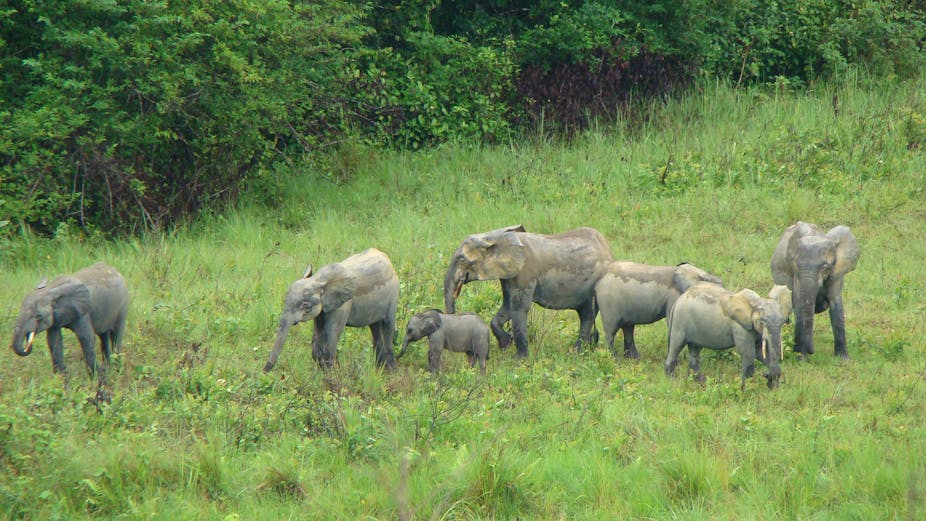Much to my excitement, my PhD research was recently published in PLOS ONE. I was studying African forest elephants that live in the dense forests of Central and West Africa to learn more about this understudied species that is threatened with extinction.
There were many emotions involved in completing a six year piece of PhD research, none of which can really be featured in the scientific method. Investigating the relationships of African forest elephants didn’t involve too much blood, but there were some tears, much perspiration and a lot of elephant dung.
Angry elephant risk
The park that I worked in, Lopé National Park in Gabon, is notorious for having aggressive elephants. This meant a slower research process and smaller sample sizes. I was collecting elephant dung across the largest possible area to examine the DNA of the region’s forest elephants. I was trying to capture how elephants related to each other across the area so I wanted to cover as much ground as possible and as quickly as possible to make sure the elephants didn’t move around too much.
With the help of Gabonese field assistants, we would set out to collect fresh dung each morning. The samples had to be fresh because the DNA degrades quickly. But if there was a grouchy elephant on the trail, we would have to abandon the whole section. The risk of being charged at in Lopé is very real so it was not uncommon for us to start a route and have to backtrack to avoid an angry elephant.
Sample sweats
If I were sampling in a park in East or Southern Africa, I could probably have driven across the park quite efficiently, covering large sections in just a day. But in most Central and West African parks, there are few, if any, roads. Lopé has some, but they are only located in a small portion of the park.

Sampling a larger area required a lot of footwork. Looking at a map you might think getting from A to B was easily done in a day, but the reality required a one-week camping trip. This meant constantly having to scale down what was achievable, logistically and financially. Large hills, deep ravines and confrontational elephants were consistent natural barriers.
Collecting the samples started off slow. Pouring rain meant we couldn’t go out on the first day. The next day, we got about six samples. At that rate, the study would not have enough samples to work.
I began to lose hope, but luckily things picked up and over time, I gained an average of about 50 samples per session. During one session, it seemed like the elephants were especially on my side, leaving specimens all over the place – I never thought I would get so excited about dung.
Truth time
After the success of collecting so many samples came the scary part – the genetics. The genetics was scary because it held the “truth”. My biggest fear was that my sample size was going to be insufficient. What if I spent all of that time running around the park only to have collected dung from the same few elephants? There was no way of knowing if my samples were from different individuals until the samples were processed.
The first step was identifying individuals from the samples. This was done through microsatellites – short repeats of sequences of DNA – in the different dung samples. This was not always successful, as microsatellites could not always be amplified to a sufficient degree to be sure that they were from unique individuals. Though dung is a great source for collecting DNA, as it is abundant and non-invasive, the overall quality is lower, meaning some samples had to be abandoned.
Then came the analysis to see what they told us about the relationships of African forest elephants. Females interest me in particular because in African savanna elephants, they are the more social sex. In forest elephants, groups can exist, but they are much smaller and we do not fully understand what the relationships are. Male forest elephants are solitary except when pursuing mates. Juvenile elephants are dependent on adult females so using their samples would not be independent.
While I would have preferred more samples, my research provided important information, especially considering how little is known about the African forest elephant. With the samples I gathered and through looking at patterns over time, there was an association between genetic and geographic distances between individuals. Also, individuals within groups tended to associate with other individuals of closer genetic relatedness and groups mostly shared DNA that reflects maternal inheritance.
When I started reading about forest elephants, I could not believe how little information is known about them and how understudied they are. My research contributes to the much-needed knowledge base of this endangered species and hopefully will encourage others to build upon it with future studies.
This is an edited version of an article that was first published in WildlifeSNPits

